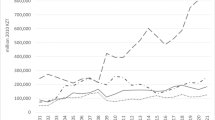Abstract
In the past 50 years, the US copper mining industry has experienced remarkable changes. During the 1970s and early 1980s, the US copper mining industry suffered a major recession. However, a few companies survived by implementing severe cost-cutting measures through innovation and technological changes. These efforts, in turn, helped quintuple labor productivity in the three decades following. Then from 2003 to 2012, labor productivity declined sharply to the levels equal to those of the early 1980s. This decline, following years of rising productivity, has led to questioning the effects of innovation and technological change on mining labor productivity. It has been argued that new technology will no longer be able to offset the adverse effects of depletion thus resulting in higher prices in the future. This study investigates the determinants of copper mining labor productivity empirically, and the extent to which they may vary cyclically for longer time spans (1965 to 2015) from the US perspective. The statistical model examines the level of labor productivity as a function of copper price, recoverable copper content of ore (percentage yield), production share of leaching, mine production index, and time trend. Overall, the results support the conclusion that falling productivity is mostly cyclical.






Similar content being viewed by others
Notes
Initiation of leaching in old and new waste-dumps, starting heap leaching of selected low grade ores and in-situ leaching.
Cut-off grade is the minimum grade required in order for a metal to be economically mined.
$$ \mathrm{Cut}-\mathrm{off}\ \mathrm{Grade}=\frac{\mathrm{Costs}}{\mathrm{Commodity}\ \mathrm{Price}\ \mathrm{x}\ \mathrm{Recovery}} $$Copper yield is the percentages of recovered copper content which is equal to head grade times recovery rate. The head grade is the average grade of metal that will be fed into the mill of process plant.
\( {\mathrm{MPI}}_i=\sum \frac{Q_{it}}{Q_t}\frac{Q_{it}}{Q_{i65}}100 \);where Qit production of ith mine in year t, Qt total mine production in year t and Qi65 production of ith mine in year 1965 for t from 1965 to 2015 (MPI1965 = 100). The following selected mines: Morenci, Bingham Canyon, Ray, Bagdad, Sierrita, Tyrone, Chino, Mission, Silver Bell, Miami, Pinto Valley, Safford, and Robinson.
References
ADMMR (1970) Copper Industry Statistics for 1970 Compared with Other Years Arizona, United States and World. Arizona Department of Mineral Resources, Phoenix, Arizona
Andrews DH (1989) “Cost Reduction by U.S. Mineral Producer: Real or Illusory?” Master Thesis, Colorado School of Mines
Annual Reports (form 10-K, Various Years, Phelps Dodge Corporation, Freeport-Mcmoran Copper & Gold Inc., Grupo Mexico, S.A.B. De C.V., Rio Tinto, KGHM International Ltd.), Retrieved from https://www.secinfo.com/https://www.secinfo.com/. Accessed 03 Aug 2018
ASU (2015) The Economic Impact of the Mining Industry on the State of Arizona-2014, Prepared for the Arizona mining association by L. William Seidman Research Institute W. P. Carey School of Business, Arizona State University. http://www.azmining.com/uploads/AMA%20report%202014%20v2%20.pdf. Accessed 15 Aug 2018
Aydin H (1998) Labor productivity growth in the U.S. copper industry. Unpublished PhD dissertation, Colorado School of Mines, Golden, CO.
Aydin H, Tilton JE (2000) Mineral endowment, labor productivity, and comparative advantage in mining. Resour Energy Econ 22:281–293
Bartos PJ (2002) SX-EW copper and the technology cycle. Resour Policy 28(3):85–94
Beard RR (1989) The primary copper industry of Arizona in 1987, Special Report:14. Arizona Department of Mineral Resources, Phoenix, Arizona
Bradley C, Sharpe A (2009) A detailed analysis of the productivity performance of mining in Canada, CSLS research report 2009–7, Ottawa. http://www.csls.ca/reports/csls2009-8.pdf. Accessed 15 Aug 2018
Jakelski D, Lebrasseur R (1997) Implementing continuous improvement in the north American mining industry. Technol Forecast Soc Chang 55(2):165–177
MSHA (1983-2015) U.S. mine safety and health administration. Mine Data Retrieval System. https://arlweb.msha.gov/drs/drshome.htm. Accessed 03 Aug 2018
MSHA (1987-2015) U.S. mine safety and health administration. Mine Data Retrieval System. https://arlweb.msha.gov/drs/drshome.htm. Accessed 03 Aug 2018
Pincock A, Holt (1996) Copper technology to year 2000, Information Bulletin 96–1
Porter KE, Peterson GR (1992) The availability of primary copper in market economy countries. Bureau of Mines, IC 9310. https://www.cdc.gov/niosh/mining/UserFiles/works/pdfs/ic9310.pdf. Accessed 15 Aug 2018
Power TM (2007) The economic role of metal mining in Minnesota: past, present, and future, Report for Minnesota Center for Environmental Advocacy and the Sierra Club. https://www.sosbluewaters.org/Economic+Role+of+Metal+Mining+in+Minnesota_smaller.pdf. Accessed 15 Aug 2018
Tilton JE (2001) Labour productivity, costs and mine survival during a recession. Resour Policy 27(2001):107–117
Tilton JE (2014) Cyclical and secular determinants of productivity in the copper, aluminum, iron ore, and coal industries. Miner Econ 27(1):1–19. https://doi.org/10.1007/s13563-014-0045-9
Tilton JE, Landsberg HH (1999) Innovation, productivity growth, and the survival of the U.S. copper industry. In: Simpson RD (ed) Sources of Productivity Improvement in U.S. Natural Resources Industries. Resources for the Future, Washington DC
USA GDP Deflator (1929-2017) https://fred.stlouisfed.org/series/A191RD3A086NBEA 2012=100. Accessed 15 Aug 2018
USGS (1965-2015) Copper chapter of minerals yearbook, vol. 1. US geological survey. https://minerals.usgs.gov/minerals/pubs/commodity/copper/index.html#myb. Accessed 15 Aug 2018
USGS (2002) Copper chapter of minerals yearbook, vol. 1. US geological survey. pp 22.1–22.8 https://minerals.usgs.gov/minerals/pubs/commodity/copper/coppemyb02r.pdf. Accessed 15 Aug 2018
USGS (2012) Metal prices in the United States through 2010, Scientific Investigations Report 2012–5188. https://pubs.usgs.gov/sir/2012/5188/sir2012-5188.pdf. Accessed 15 Aug 2018
Author information
Authors and Affiliations
Corresponding author
Additional information
This article is dedicated to John Tilton on the occasion of his 80th birthday for his contributions to mineral economics and its use in understanding the behavior of mineral commodity markets, for the patient guidance, encouragement and advice he has provided throughout my time as his student and for his kind and firm friendship.
Rights and permissions
About this article
Cite this article
Aydin, H. Fifty years of copper mining: the US labor productivity. Miner Econ 33, 11–19 (2020). https://doi.org/10.1007/s13563-018-00167-y
Received:
Accepted:
Published:
Issue Date:
DOI: https://doi.org/10.1007/s13563-018-00167-y




